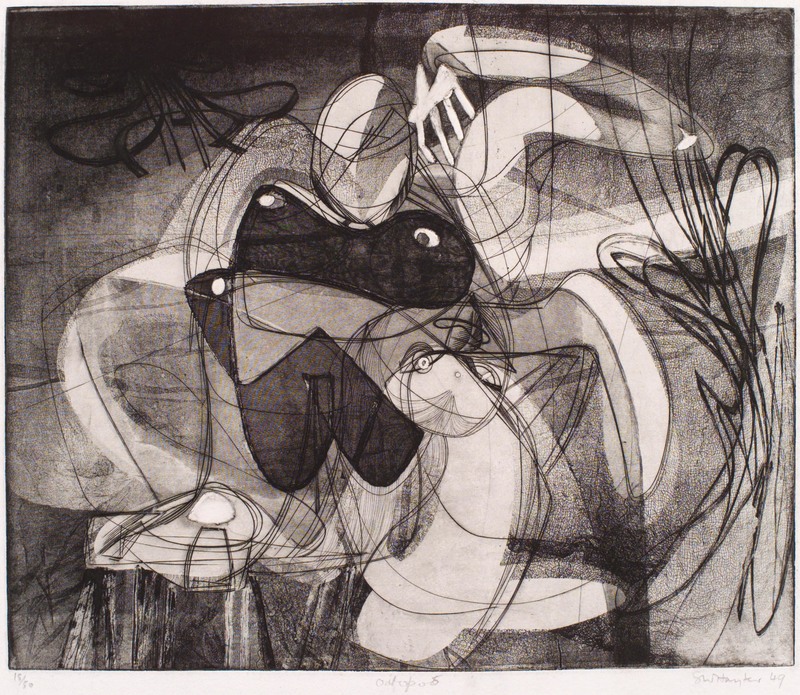Octopod
Item
Title
Octopod
Creator
Stanley William Hayter
English, 1901–1988
English, 1901–1988
Date
1949
Materials
Engraving, soft-ground etching, and gauffrage
Measurements
Plate: 14-7/8 x 17-11/16 in. (37.8 x 44.9 cm), sheet: 20-3/8 x 26-5/8 in. (51.8 x 68 cm)
Description
One of the last prints produced by Hayter during his New York tenure, Octopod displays, in addition to the artist’s typically virtuosic engraving, two of Atelier 17’s most widely recognized trademarks. Virtually all of the tonal areas were accomplished by pressing a variety of materials—mostly closely woven cloth and more irregularly meshed gauzes—onto a plate first prepared with a soft ground. When the materials were removed, their impressions laid bare the metal, thus insuring the transfer of their textures when the plate was etched, or bathed in acid. The raised white areas in the print were achieved by gouging the plate with a scorper deep enough so that when the plate was inked and wiped, the gouges remained ink free. When subsequently passed through a press, the paper was forced into the excavations, resulting in a colorless relief—called gauffrage, after the French word for embossing—that rises significantly above the plane of the sheet. These techniques were employed almost ubiquitously in the workshop, and one or both can be discerned in most of the other prints on view in the exhibition.
A passionate fisherman, Hayter maintained a life-long fascination with the danger and brilliance of water, as well as with the things that live in it. Beginning in the late 1940s, this interest found its way into his work with growing regularity, gradually supplanting his penchant for exploring mythical themes. Octopod, curiously completed around the same time that Minna Citron produced Squid Under Pier, was one of Hayter’s first efforts in this new direction. Titled after the zoological term for an octopus, the print’s glowing whites and arm-like gestures, flailing in every direction amidst a murky entanglement, were likely intended not so much as a direct portrayal of the elusive sea creature but rather as a means of subjectively accessing the mystery and magnitude of its deep sea world.
The text for this label has been adapted in part from an unpublished essay by former Penn State art history graduate student Barbara Kutis (MA 2007).
A passionate fisherman, Hayter maintained a life-long fascination with the danger and brilliance of water, as well as with the things that live in it. Beginning in the late 1940s, this interest found its way into his work with growing regularity, gradually supplanting his penchant for exploring mythical themes. Octopod, curiously completed around the same time that Minna Citron produced Squid Under Pier, was one of Hayter’s first efforts in this new direction. Titled after the zoological term for an octopus, the print’s glowing whites and arm-like gestures, flailing in every direction amidst a murky entanglement, were likely intended not so much as a direct portrayal of the elusive sea creature but rather as a means of subjectively accessing the mystery and magnitude of its deep sea world.
The text for this label has been adapted in part from an unpublished essay by former Penn State art history graduate student Barbara Kutis (MA 2007).
Source
Palmer Museum of Art, The Pennsylvania State University, Purchased with funds from the Terra Art Enrichment Fund
Identifier
2005.40
Rights
This image is posted publicly for non-profit educational uses, excluding printed publication. Other uses are not permitted.

